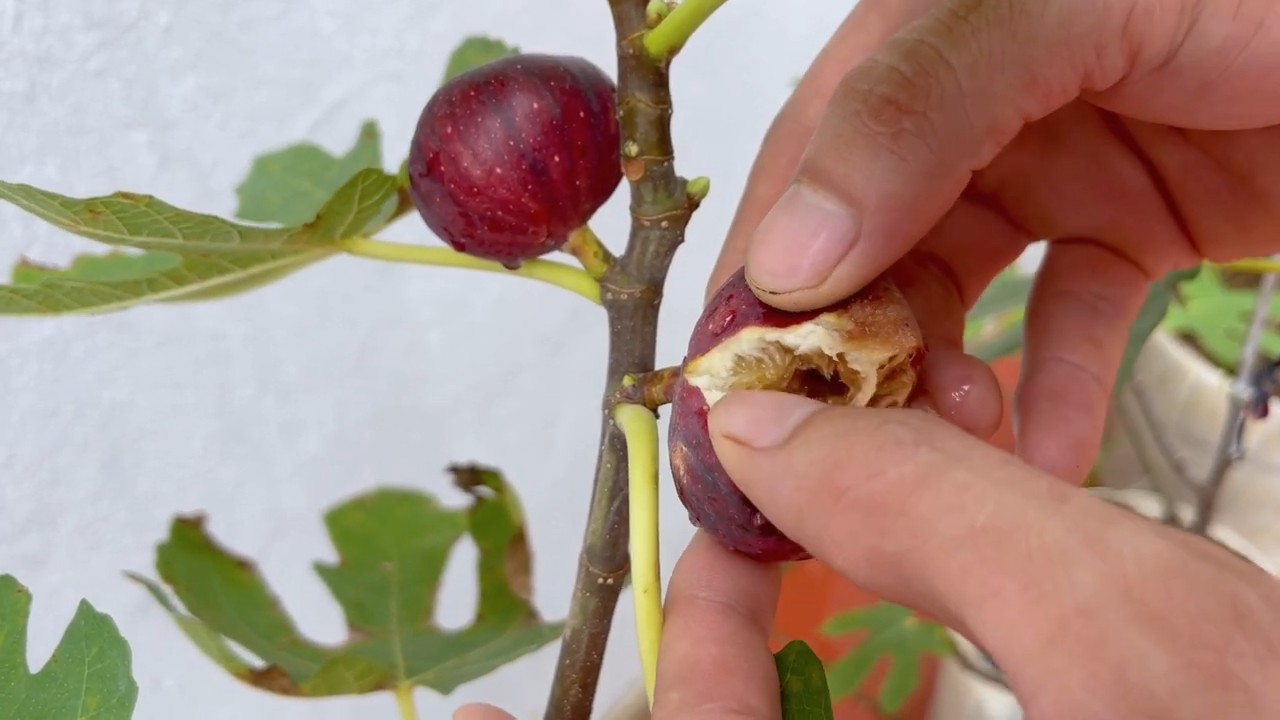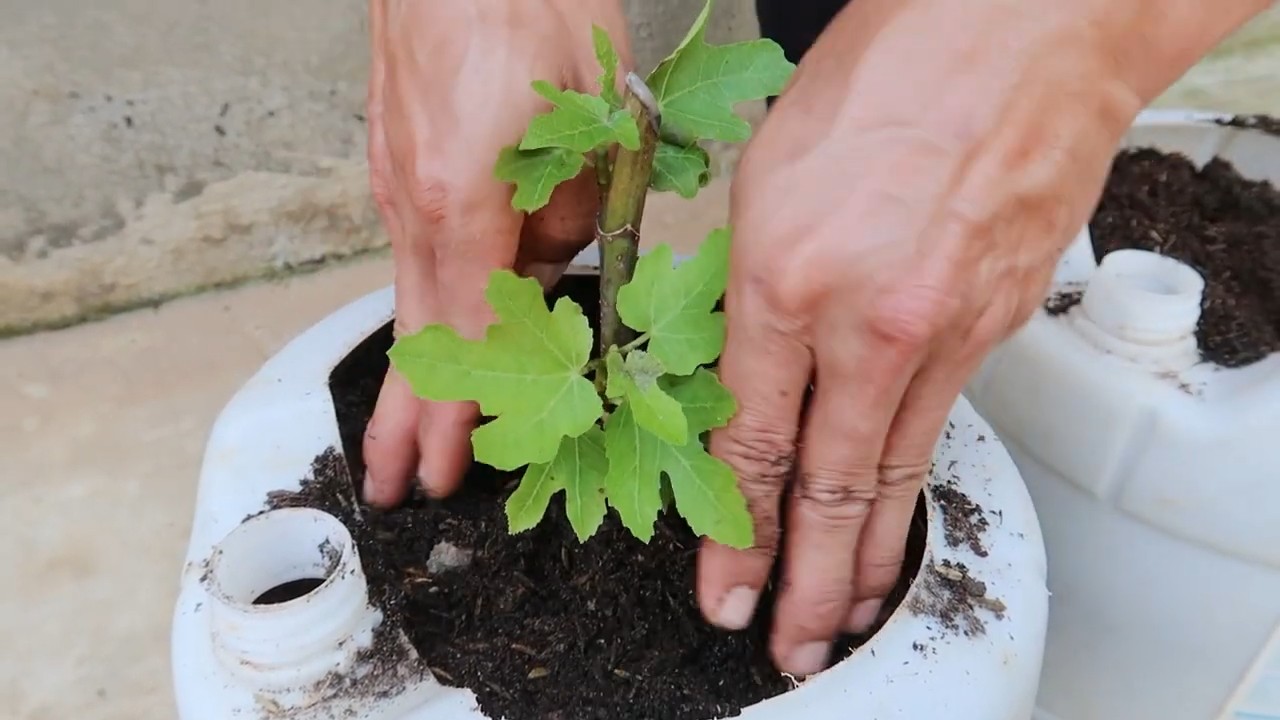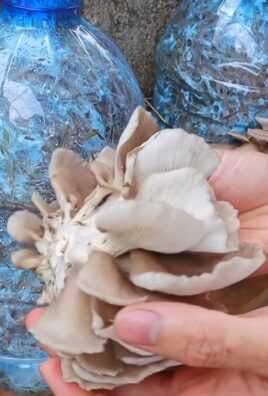Growing Figs in Containers might seem like a challenge, especially if you’re short on space or live in a cooler climate. But trust me, it’s totally achievable and incredibly rewarding! Imagine plucking sweet, juicy figs right from your patio – that’s the magic we’re unlocking today.
Figs have a rich history, dating back to ancient civilizations. They were prized by the Romans and Egyptians, and even mentioned in the Bible! For centuries, these delectable fruits have symbolized prosperity and abundance. While traditionally grown in orchards, the beauty of container gardening allows us to enjoy this ancient fruit, no matter where we live.
Why should you try growing figs in containers? Well, for starters, it gives you complete control over the growing environment. You can move your fig tree indoors during harsh winters, ensuring a bountiful harvest year after year. Plus, it’s a fantastic way to add a touch of Mediterranean charm to your balcony, patio, or even your living room! I’m going to share some simple, yet effective DIY tricks and hacks that will have you harvesting delicious figs in no time. Get ready to unleash your inner gardener and transform your space into a fig-filled paradise!

Feigen im Topf ziehen: Dein DIY-Guide für eine reiche Ernte
Hallo liebe Gartenfreunde! Ich liebe Feigen. Diese süßen, saftigen Früchte sind einfach unwiderstehlich. Aber was, wenn du keinen Garten hast? Keine Sorge! Du kannst Feigen auch wunderbar in Töpfen ziehen. Ich zeige dir, wie es geht, damit auch du bald deine eigenen, frischen Feigen ernten kannst.
Warum Feigen im Topf ziehen?
Feigen im Topf zu ziehen hat einige Vorteile:
* Flexibilität: Du kannst den Topf leicht umstellen, um die Pflanze vor extremen Wetterbedingungen zu schützen.
* Kontrolle: Du hast mehr Kontrolle über die Bodenqualität und die Bewässerung.
* Platzsparend: Ideal für Balkone, Terrassen oder kleine Gärten.
* Überwinterung: In kälteren Regionen kannst du den Topf einfach ins Haus holen, um die Pflanze vor Frost zu schützen.
Was du brauchst: Die Materialliste
Bevor wir loslegen, hier eine Liste mit allem, was du brauchst:
* Feigenbaum-Setzling: Wähle eine Sorte, die für den Anbau im Topf geeignet ist. Beliebte Sorten sind ‘Brown Turkey’, ‘Little Miss Figgy’ oder ‘Celeste’.
* Großer Topf: Mindestens 40-50 cm Durchmesser und Tiefe. Terrakotta oder Kunststoff sind beide geeignet, aber Terrakotta ist atmungsaktiver.
* Hochwertige Blumenerde: Eine Mischung aus Gartenerde, Kompost und Sand ist ideal.
* Drainagematerial: Blähton, Kies oder Tonscherben für den Boden des Topfes.
* Gartenschere: Zum Beschneiden der Pflanze.
* Gießkanne: Zum Bewässern.
* Dünger: Ein Langzeitdünger oder Flüssigdünger für Obstbäume.
* Mulch: Rindenmulch oder Stroh, um die Feuchtigkeit im Boden zu halten.
* Handschuhe: Zum Schutz deiner Hände.
Schritt-für-Schritt-Anleitung: So pflanzt du deinen Feigenbaum
1. Den Topf vorbereiten: Zuerst sorge ich für eine gute Drainage. Ich fülle den Boden des Topfes mit einer Schicht Blähton oder Kies. Das verhindert Staunässe, die Feigenbäume gar nicht mögen.
2. Die Erde mischen: Jetzt mische ich die Blumenerde. Ich nehme eine hochwertige Blumenerde und mische sie mit etwas Kompost und Sand. Der Kompost sorgt für Nährstoffe und der Sand für eine gute Durchlässigkeit. Eine gute Mischung ist etwa 2 Teile Blumenerde, 1 Teil Kompost und 1 Teil Sand.
3. Den Feigenbaum einsetzen: Ich nehme den Feigenbaum-Setzling vorsichtig aus dem Anzuchttopf. Wenn die Wurzeln sehr dicht sind, lockere ich sie etwas auf. Dann setze ich den Baum mittig in den Topf und fülle ihn mit der Erdmischung auf. Achte darauf, dass der Wurzelballen vollständig bedeckt ist, aber der Stamm nicht zu tief in der Erde steckt.
4. Angießen: Nach dem Einpflanzen gieße ich den Feigenbaum gründlich an. Das hilft der Erde, sich zu setzen und die Wurzeln zu befeuchten.
5. Mulchen: Ich verteile eine Schicht Rindenmulch oder Stroh um den Stamm des Feigenbaums. Das hält die Feuchtigkeit im Boden und unterdrückt Unkraut.
Die richtige Pflege: So bleibt dein Feigenbaum glücklich
Bewässerung
Feigenbäume mögen es feucht, aber nicht nass. Ich gieße meinen Feigenbaum regelmäßig, besonders während der Wachstumsperiode im Frühjahr und Sommer. Ich prüfe immer, ob die oberste Erdschicht trocken ist, bevor ich wieder gieße. Im Winter reduziere ich die Wassermenge, da der Baum dann weniger Wasser benötigt. Staunässe solltest du unbedingt vermeiden, da sie zu Wurzelfäule führen kann.
Düngung
Feigenbäume sind hungrig! Ich dünge meinen Feigenbaum regelmäßig, um sicherzustellen, dass er genügend Nährstoffe bekommt. Im Frühjahr beginne ich mit einem Langzeitdünger für Obstbäume. Alternativ kannst du auch alle zwei Wochen einen Flüssigdünger verwenden. Achte darauf, die Anweisungen auf der Verpackung zu befolgen, um eine Überdüngung zu vermeiden. Im Herbst stelle ich die Düngung ein, damit der Baum sich auf den Winter vorbereiten kann.
Standort
Feigenbäume lieben die Sonne! Ich stelle meinen Feigenbaum an einen sonnigen Standort, wo er mindestens 6-8 Stunden Sonne pro Tag bekommt. Ein Südbalkon oder eine Terrasse ist ideal. Wenn du in einer Region mit sehr heißen Sommern lebst, kann es sinnvoll sein, den Baum während der heißesten Stunden des Tages etwas zu beschatten.
Beschneiden
Das Beschneiden ist wichtig, um die Form des Baumes zu erhalten und die Fruchtbildung zu fördern. Ich beschneide meinen Feigenbaum im späten Winter oder frühen Frühjahr, bevor er neu austreibt. Ich entferne abgestorbene oder kranke Äste und kürze lange Triebe ein, um die Verzweigung zu fördern. Achte darauf, saubere und scharfe Gartenscheren zu verwenden, um die Pflanze nicht zu verletzen.
Überwinterung
In kälteren Regionen musst du deinen Feigenbaum im Winter schützen. Ich stelle meinen Topf in einen kühlen, aber frostfreien Raum, z.B. eine Garage oder einen Keller. Der Baum benötigt im Winter nur wenig Licht und Wasser. Im Frühjahr, wenn die Temperaturen steigen, kann ich den Baum wieder nach draußen stellen. Achte darauf, ihn langsam an die Sonne zu gewöhnen, um Sonnenbrand zu vermeiden.
Häufige Probleme und Lösungen
* Blattfall: Blattfall kann verschiedene Ursachen haben, z.B. zu wenig Wasser, zu viel Wasser, zu wenig Licht oder Schädlinge. Überprüfe die Bedingungen und passe sie entsprechend an.
* Keine Früchte: Wenn dein Feigenbaum keine Früchte trägt, kann das an zu wenig Sonne, zu wenig Dünger oder einem falschen Schnitt liegen. Stelle sicher, dass der Baum genügend Sonne bekommt, dünge ihn regelmäßig und beschneide ihn richtig.
* Schädlinge: Feigenbäume können von verschiedenen Schädlingen befallen werden, z.B. Blattläusen, Spinnmilben oder Schildläusen. Kontrolliere den Baum regelmäßig und bekämpfe Schädlinge bei Bedarf mit geeigneten Mitteln. Ich bevorzuge biologische Schädlingsbekämpfungsmittel.
* Wurzelfäule: Wurzelfäule wird durch Staunässe verursacht. Achte darauf, dass der Topf eine gute Drainage hat und gieße nicht zu viel.
Die Ernte: Der Lohn deiner Mühe
Nach all der Arbeit kommt der schönste Teil: die Ernte! Feigen sind reif, wenn sie weich sind und leicht vom Baum fallen. Die Farbe der Frucht hängt von der Sorte ab. Ich ernte meine Feigen, indem ich sie vorsichtig vom Baum drehe. Frische Feigen sind ein wahrer Genuss! Du kannst sie pur essen, in Salaten verwenden oder zu Marmelade verarbeiten.
Zusätzliche Tipps für eine erfolgreiche Feigenernte
* Wähle die richtige Sorte: Nicht alle Feigensorten sind für den Anbau im Topf geeignet. Informiere dich vor dem Kauf, welche Sorten sich gut eignen.
* Verwende einen großen Topf: Ein großer Topf bietet den Wurzeln genügend Platz zum Wachsen.
* Achte auf eine gute Drainage: Staunässe kann zu Wurzelfäule führen.
* Dünge regelmäßig: Feigenbäume benötigen viele Nährstoffe.
* Schütze den Baum vor Frost: In kälteren Regionen musst du den Baum im Winter schützen.
* Sei geduldig: Es kann einige Jahre dauern, bis dein Feigenbaum Früchte trägt.
Ich hoffe, dieser Guide hilft dir dabei, deine eigenen Feigen im Topf zu ziehen. Mit etwas Geduld und Pflege wirst du bald mit einer reichen Ernte belohnt. Viel Erfolg und guten Appetit!

Conclusion
So, there you have it! Growing figs in containers isn’t just a possibility; it’s a rewarding and accessible way to enjoy fresh, delicious figs even without a sprawling orchard. We’ve walked through the essential steps, from selecting the right container and variety to providing the necessary care for your fig tree to thrive.
Why is this DIY trick a must-try? Because it democratizes fig cultivation. No longer are these delectable fruits reserved for those with acres of land or a Mediterranean climate. Container gardening allows anyone, regardless of their living situation, to experience the joy of nurturing a fig tree and harvesting its sweet bounty. Imagine stepping onto your balcony or patio and plucking a sun-ripened fig, still warm from the sun – a truly unparalleled experience.
Beyond the sheer convenience, growing figs in containers offers greater control over the plant’s environment. You can easily move your fig tree to chase the sun, protect it from harsh weather, and even manipulate its dormancy period to potentially yield multiple harvests in a single year. This level of control is simply not possible with in-ground planting.
But the beauty of this DIY project lies not only in its practicality but also in its adaptability. Feel free to experiment with different fig varieties to discover your personal favorite. Consider adding companion plants to your container to enhance the soil health and attract beneficial insects. You could even try espaliering your fig tree against a wall or trellis for a visually stunning and space-saving display.
Here are a few suggestions and variations to spark your creativity:
* Vertical Gardening: Train your fig tree to grow up a trellis or support structure. This is especially useful for smaller patios or balconies.
* Dwarf Varieties: Explore dwarf fig varieties specifically bred for container growing. These varieties tend to be more compact and manageable.
* Companion Planting: Plant herbs like basil, thyme, or rosemary in the same container as your fig tree. These herbs can help deter pests and improve soil drainage.
* Seasonal Decorations: Decorate your fig tree with lights during the holidays or add colorful ribbons for a festive touch.
Ultimately, growing figs in containers is a journey of discovery. It’s about connecting with nature, learning about plant care, and savoring the fruits of your labor. We encourage you to embrace the challenge, get your hands dirty, and experience the satisfaction of growing your own figs.
Don’t be afraid to experiment, adapt, and personalize the process to suit your unique circumstances and preferences. And most importantly, don’t forget to share your experiences with us! We’d love to hear about your successes, challenges, and any tips or tricks you’ve discovered along the way. Share your photos, stories, and questions in the comments section below. Let’s build a community of fig-loving container gardeners and inspire others to embark on this rewarding adventure. This **DIY fig growing** method is sure to bring you joy.
Frequently Asked Questions (FAQ)
What is the best type of container for growing figs?
The ideal container for growing figs should be large enough to accommodate the tree’s root system, provide adequate drainage, and be made of a durable material that can withstand the elements. A container that is at least 20-25 gallons in size is generally recommended for mature fig trees. Terracotta pots, plastic containers, and even repurposed barrels can be used, as long as they have drainage holes. Consider the weight of the container, especially if you plan to move it frequently. Dark-colored containers can absorb more heat, which can be beneficial in cooler climates but may overheat the roots in hotter regions.
Which fig varieties are best suited for container growing?
Several fig varieties thrive in containers. Some popular choices include ‘Brown Turkey,’ ‘Chicago Hardy,’ ‘Little Miss Figgy,’ ‘Celeste,’ and ‘Black Mission.’ Dwarf varieties, such as ‘Petite Negra,’ are also excellent options for smaller spaces. When selecting a variety, consider your local climate, the size of your container, and your personal taste preferences. Research the specific characteristics of each variety to ensure it’s a good fit for your growing conditions.
How often should I water my container fig tree?
Watering frequency depends on several factors, including the size of the container, the type of soil, the climate, and the stage of growth. Generally, fig trees in containers need to be watered more frequently than those planted in the ground. Check the soil moisture regularly by sticking your finger about an inch or two into the soil. If the soil feels dry to the touch, it’s time to water. Water deeply until excess water drains out of the drainage holes. Avoid overwatering, as this can lead to root rot. During hot, dry weather, you may need to water your fig tree daily. In cooler, wetter weather, you may only need to water it once or twice a week.
What type of soil is best for container fig trees?
Fig trees prefer well-draining soil that is rich in organic matter. A good potting mix for container fig trees should consist of a combination of potting soil, compost, and perlite or vermiculite. This mixture will provide adequate drainage, aeration, and nutrients for the tree’s roots. Avoid using garden soil, as it can be too heavy and compact for container growing. You can also add a slow-release fertilizer to the potting mix to provide a steady supply of nutrients.
How much sunlight do container fig trees need?
Fig trees need at least 6-8 hours of direct sunlight per day to thrive. Place your container fig tree in a location that receives plenty of sunlight, such as a south-facing balcony or patio. If you live in a region with intense summer heat, you may need to provide some afternoon shade to prevent the leaves from scorching. Rotate the container regularly to ensure that all sides of the tree receive adequate sunlight.
How do I fertilize my container fig tree?
Fig trees benefit from regular fertilization, especially during the growing season. Use a balanced fertilizer with an NPK ratio of 10-10-10 or 20-20-20. Follow the instructions on the fertilizer label for application rates. Fertilize your fig tree every 4-6 weeks during the spring and summer months. Reduce or stop fertilizing during the fall and winter months when the tree is dormant. You can also supplement with organic fertilizers, such as compost tea or fish emulsion.
How do I prune my container fig tree?
Pruning is essential for maintaining the shape and size of your container fig tree, as well as for promoting fruit production. Prune your fig tree in late winter or early spring, before new growth begins. Remove any dead, damaged, or crossing branches. Thin out the canopy to improve air circulation and sunlight penetration. You can also prune to shape the tree and control its size. Be careful not to over-prune, as this can reduce fruit production.
How do I protect my container fig tree from pests and diseases?
Container fig trees are generally less susceptible to pests and diseases than those planted in the ground. However, it’s still important to monitor your tree regularly for any signs of problems. Common pests that can affect fig trees include aphids, spider mites, and scale insects. Treat infestations with insecticidal soap or neem oil. Diseases that can affect fig trees include fig rust and leaf spot. Prevent these diseases by providing good air circulation and avoiding overwatering.
How do I overwinter my container fig tree?
In colder climates, container fig trees need to be protected from freezing temperatures during the winter months. There are several ways to overwinter your fig tree:
* Bring it indoors: Move the container fig tree to a cool, dark, and frost-free location, such as a garage or basement. Water sparingly during the winter months, just enough to keep the soil from completely drying out.
* Wrap the container: Wrap the container with burlap or bubble wrap to insulate the roots from the cold.
* Bury the container: Dig a hole in the ground and bury the container up to the rim. Cover the tree with a layer of mulch or straw.
In the spring, gradually acclimate your fig tree to outdoor conditions before moving it back to its permanent location.
Can I get two crops of figs in one year from a container fig tree?
Yes, it is possible to get two crops of figs in one year from a container fig tree, especially with certain varieties and proper care. The first crop, known as the “breba” crop, develops on the previous year’s growth. The second crop, known as the “main” crop, develops on the current year’s growth. To encourage two crops, provide your fig tree with optimal growing conditions, including plenty of sunlight, water, and fertilizer. You can also manipulate the tree’s dormancy period by bringing it indoors during the winter months and then gradually acclimating it to outdoor conditions in the spring.




Leave a Comment